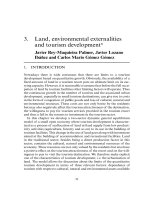THE ECONOMICS OF MONEY,BANKING, AND FINANCIAL MARKETS 454
Bạn đang xem bản rút gọn của tài liệu. Xem và tải ngay bản đầy đủ của tài liệu tại đây (37.32 KB, 1 trang )
422
PA R T V
Central Banking and the Conduct of Monetary Policy
THE MO NE Y MU LTI PL IE R
The intuition in the section above is sufficient for you to understand how the
money supply process works. For those of you who are more mathematically
inclined, we can derive all of the above results using a concept called the money
multiplier, denoted by m, which tells us how much the money supply changes
for a given change in the monetary base. The relationship among the money supply, the money multiplier, and the monetary base is described by the following
equation:
M
m
(2)
MB
The money multiplier m tells us what multiple of the monetary base is transformed
into the money supply. Because the money multiplier is larger than 1, the alternative name for the monetary base, high-powered money, is logical: a $1 change in
the monetary base leads to more than a $1 change in the money supply.
Deriving the
Money
Multiplier
Let s assume that the desired holdings of currency C, like desired reserves DR, grows
proportionally with chequable deposits D; in other words, we assume that the ratios
of these items to chequable deposits are constants in equilibrium:
c
r
currency ratio, C/D
desired reserve ratio, DR/D
We will now derive a formula that describes how the currency ratio desired by
depositors c and the reserves ratio desired by banks r affect the money multiplier
m. We begin the derivation of the model of the money supply with the equation
R
DR
which states that the total amount of reserves in the banking system R equals
desired reserves DR. (Note that this equation corresponds to the equilibrium condition DR
R, where excess reserves were assumed to be zero.)
The total amount of desired reserves equals the desired reserve ratio r times
the amount of chequable deposits D :
DR
r
D
Substituting r D for DR in the first equation yields an equation that links reserves
in the banking system to the amount of chequable deposits they can support:
R
r
D
A key point here is that banks set the desired reserve ratio r to be less than 1. Thus
$1 of reserves can support more than $1 of deposits, and the multiple expansion
of deposits can occur.
Let s see how this works in practice. If the desired reserve ratio is r 0.05, and
the level of chequable deposits in the banking system is $800 billion, the amount
of reserves needed to support these deposits is $40 billion ( 0.05 $800 billion).
The $40 billion of reserves can support twenty times this amount in chequable
deposits, because multiple deposit creation will occur.
Because the monetary base MB equals currency C plus reserves R, we can generate an equation that links the amount of monetary base to the levels of
chequable deposits and currency by adding currency to both sides of the equation:
MB
C
R
C
(r
D)









